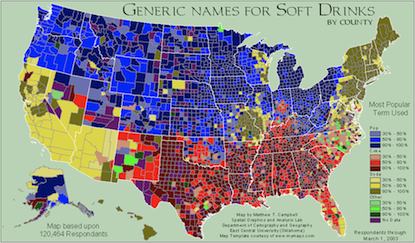Harman links to this lovely map infographic of generic names for soft drinks in the United States (click below for a bigger version).
It’s been around for a while but is worth revisiting in light of a few points Graham makes in his post.
First, Graham wonders what comprises the green “other” category in these maps, which is far more prevalent than would seem likely. I’m sure I don’t know of all the names, but in addition to the standards “pop,” “soda,” and “coke,” parts of the mid-atlantic and southeast sometimes say “drink” or “cold drink” when they mean “soda.” I’ve heard that this name sometimes appears in Louisiana and Texas, but I’d be surprised if it were the dominant one in New Mexico’s Socorro and Torrance counties, two of the most visibly green western areas on the map.
Second, Graham gives us southerner’s a little tease for the act of calling any soft drink a “Coke,” calling it “simply illogical” [Harman has since responded; we know it was but a playful prod!] I have a few responses. For one, we don’t call them “Cokes,” we call them “cokes.” I’m sure you can see the difference.
For another, we have a different, more definitive name for the famous brand of cola made by my hometown soft drink company; it’s called a “Co-cola” (an elision, compare it to “Missippi” for “Mississippi”). Doesn’t it just roll off the tongue on a hot, humid day?
And for yet another thing, there’s a lovely lesson in mereology and rhetoric in the southern use of “coke.” I’d argue that “coke” is a figure of speech called a “merism,” in which a single thing is described by a set of its most conspicuous parts. One common example of merism is in Genesis: “the heavens and the earth” is a merism for the entire universe. Another is “flesh and bone” for the body. Some might argue that the substition of “coke” for “soda” is really synecdoche, but I disagree, and here’s why: in the south, where Coca-Cola is king, one and only one item is conspicuous when it comes to carbonated soft drinks, and that’s Coke.

Comments
Timothy Morton
Hi–very interesting, especially since I used to write on food a lot. What we have here is strictly a metonymy. Aristotle is the go to guy. You can make metonymies out of the four causes (since metonymies describe spatiotemporal relations, as well as logical ones like part and whole (synecdoche, a subset)). Coke produces soft drinks like Hoover produces vacuum cleaners, so a vacuum cleaner *is a Hoover. Ditto Kleenex. My favorite food metonymies have to do with common descriptions like toast (efficient cause), marmite (formal cause–it’s the casserole dish you cook vegetables in), chop, roast, stuffing–wait a minute, it’s all metonymies…
Ian Bogost
Right, these things are usually taken as metonyms or as synechdoches. But as I argue above, I don’t think metonymy is a sufficient explanation in the case of “coke.” For one thing, a metonym like “the Crown” isn’t linked to the monarchy in a part/whole relationship like “Coke” is (thus the argument for synechdoche). But more so, I don’t think the usage of “coke” in the south is meant to transfer the associations of “Coke” to the general category of soft drinks. Thus my argument for its use as a merism.
This is probably a silly thing to argue about, but you know, this is the Internet 🙂
Mark Sample
I still maintain “sodee-pop” is the proper term to use for all non-alcoholic carbonated beverages.